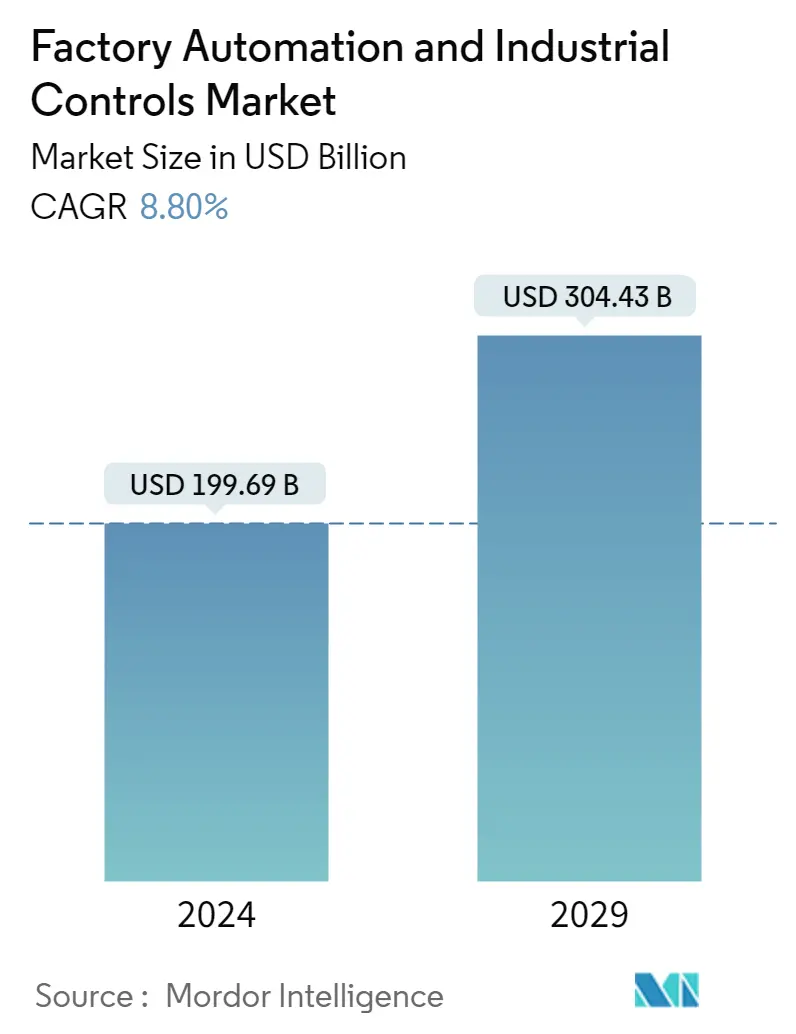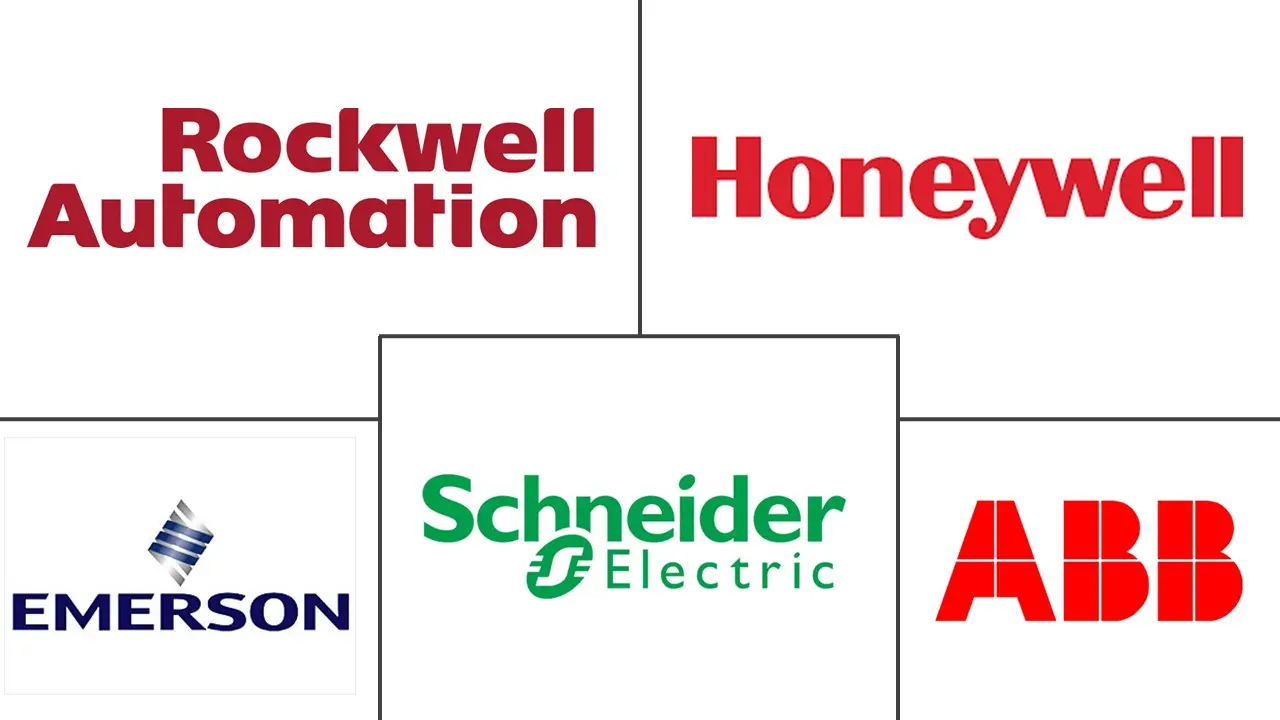Market Size of Factory Automation and Industrial Controls Industry

| Study Period | 2019 - 2029 |
| Market Size (2024) | USD 199.69 Billion |
| Market Size (2029) | USD 304.43 Billion |
| CAGR (2024 - 2029) | 8.80 % |
| Fastest Growing Market | Asia Pacific |
| Largest Market | North America |
Major Players
*Disclaimer: Major Players sorted in no particular order |
Factory Automation and Industrial Controls Market Analysis
The Factory Automation and Industrial Controls Market size is estimated at USD 199.69 billion in 2024, and is expected to reach USD 304.43 billion by 2029, growing at a CAGR of 8.80% during the forecast period (2024-2029).
Automation and control systems decrease manufacturing errors, which saves time and money and increases customer satisfaction. The creation of smart factories for planning, product development, and supply chain logistics is a result of the increased adoption of smart systems, components, machinery, and equipment for the improvement of processes through automation and self-optimization. This is a key aspect influencing the market.
- The automation industry has been revolutionized by the combination of digital and physical aspects of manufacturing aimed at delivering optimum performance. Further, the focus on achieving zero waste production and a shorter time to reach the market has augmented the growth of the market.
- The Industrial Internet of Things (IIoT) and the Industrial 4.0 are at the center of the new technological approaches for the development, production, and management of the entire logistics chain, otherwise known as smart factory automation, and are dominating the trends in the industrial sector, with machinery and devices being connected via internet.
- Moreover, massive shifts in manufacturing due to Industry 4.0 and the acceptance of IoT require enterprises to adopt agile, smarter, and innovative ways to advance production with technologies that complement and augment human labor with automation and reduce industrial accidents caused by process failure.
- Additionally, automakers worldwide are aware of the revolutionary potential of the next generation of robots and automation technologies to transform the automotive industry in terms of productivity, quality, safety, and cost parameters. The need for robot automation systems is also anticipated to benefit from rising robotic automation spending year over year.
- The cost of labor has risen exponentially in many different areas. Additionally, the standards for quality are becoming stricter. In light of this, factory automation may result in lower production, operating, and labor expenses.
- The market was disrupted when the COVID-19 epidemic forced the closure of enterprises and manufacturing facilities worldwide. Significant losses were incurred, particularly in the first two quarters of the year, as a result of the drop in demand for industrial automation systems in the manufacturing sectors. Fortunately, there have been encouraging signs of a resurgence in the first few months of 2021, owing to the reopening of the plants and the restart of industrial operations. Industry 4.0 technology advancements have increased demand for automated solutions like robots across a wide range of industrial industries.
Factory Automation and Industrial Controls Industry Segmentation
- Factory automation and industrial control is a rising trend in the manufacturing industry, which provides smart manufacturing infrastructure. Industrial control and factory automation facilitate cost efficiency, quality of production and standardize manufacturing, reliability, and flexibility in the process of manufacturing. Industrial control and factory automation offer a perfect mix of mechanical components and devices for the information technology market.
- The Global Factory Automation and Industrial Controls Market are segmented by Product ((by Industrial Control Systems(Distributed Control System (DCS), Programmable Logic Controller (PLC), Supervisory Control and Data Acquisition (SCADA), Product Lifecycle Management (PLM), Human Machine Interface (HMI), Manufacturing Execution System (MES), Enterprise Resource Planning (ERP)) Field Devices (Machine Vision System, Robotics (industrial), Sensors and Transmitters, Motors and Drivers)) End User (Automotive, Chemical and Petrochemical, Utility, Pharmaceutical, Food and Beverage, Oil and Gas) and Geography.
| By Product | ||||||||||
| ||||||||||
|
| By End-User Industry | |
| Automotive | |
| Chemical and Petrochemical | |
| Utility | |
| Pharmaceutical | |
| Food and Beverage | |
| Oil and Gas | |
| Other End-user Industries |
| By Geography | ||||||
| ||||||
| ||||||
| ||||||
| Latin America | ||||||
| Middle East & Africa |
Factory Automation and Industrial Controls Market Size Summary
The Factory Automation and Industrial Controls Market is poised for significant growth, driven by the increasing adoption of smart systems and the integration of digital and physical manufacturing processes. This evolution is largely influenced by the push towards smart factories, which enhance planning, product development, and supply chain logistics through automation and self-optimization. The market is experiencing a transformation with the rise of Industry 4.0 and the Industrial Internet of Things (IIoT), which are central to the development of smart factory automation. These technologies enable machinery and devices to be interconnected via the internet, facilitating zero waste production and faster time-to-market solutions. The automotive industry, a major player in this market, is leveraging these advancements to improve productivity, quality, and safety while reducing costs. The shift towards electric vehicles further amplifies the demand for automated solutions, as manufacturers seek to enhance production efficiency and respond swiftly to market demands.
The market landscape is characterized by a competitive environment with several key players focusing on expanding their global presence and enhancing their product offerings through strategic collaborations and acquisitions. Companies like Rockwell Automation, Honeywell, and Mitsubishi Electric are actively investing in new technologies and facilities to meet the growing demand for factory automation solutions. The COVID-19 pandemic initially disrupted the market, but recovery has been evident with the resumption of industrial operations and increased demand for automated systems across various sectors. The automotive industry, in particular, is witnessing a surge in robotic automation spending, driven by the need for cost-effective and efficient manufacturing processes. As the market continues to evolve, the adoption of smart automation technologies is expected to provide significant cost savings, improved productivity, and enhanced quality for manufacturers worldwide.
Factory Automation and Industrial Controls Market Size - Table of Contents
-
1. MARKET INSIGHTS
-
1.1 Market Overview
-
1.2 Industry Attractiveness - Porter's Five Forces Analysis
-
1.2.1 Bargaining Power of Suppliers
-
1.2.2 Bargaining Power of Consumers
-
1.2.3 Threat of New Entrants
-
1.2.4 Threat of Substitute Products
-
1.2.5 Intensity of Competitive Rivalry
-
-
1.3 Industry Value Chain Analysis
-
1.4 An Assessment of Impact of COVID-19 on the Industry
-
-
2. MARKET SEGMENTATION
-
2.1 By Product
-
2.1.1 By Industrial Control Systems
-
2.1.1.1 Distributed Control System (DCS)
-
2.1.1.2 Programmable Logic Controller (PLC)
-
2.1.1.3 Supervisory Control and Data Acquisition (SCADA)
-
2.1.1.4 Product Lifecycle Management (PLM)
-
2.1.1.5 Human Machine Interface (HMI)
-
2.1.1.6 Manufacturing Execution System (MES)
-
2.1.1.7 Enterprise Resource Planning (ERP)
-
2.1.1.8 Other Industrial Control Systems
-
-
2.1.2 Field Devices
-
2.1.2.1 Machine Vision Systems
-
2.1.2.2 Robotics (Industrial)
-
2.1.2.3 Sensors and Transmitters
-
2.1.2.4 Motors and Drives
-
2.1.2.5 Other Field Devices
-
-
-
2.2 By End-User Industry
-
2.2.1 Automotive
-
2.2.2 Chemical and Petrochemical
-
2.2.3 Utility
-
2.2.4 Pharmaceutical
-
2.2.5 Food and Beverage
-
2.2.6 Oil and Gas
-
2.2.7 Other End-user Industries
-
-
2.3 By Geography
-
2.3.1 North America
-
2.3.1.1 United States
-
2.3.1.2 Canada
-
-
2.3.2 Europe
-
2.3.2.1 United Kingdom
-
2.3.2.2 Germany
-
2.3.2.3 France
-
2.3.2.4 Rest of Europe
-
-
2.3.3 Asia-Pacific
-
2.3.3.1 China
-
2.3.3.2 India
-
2.3.3.3 Japan
-
2.3.3.4 Rest of Asia Pacific
-
-
2.3.4 Latin America
-
2.3.5 Middle East & Africa
-
-
Factory Automation and Industrial Controls Market Size FAQs
How big is the Factory Automation and Industrial Controls Market?
The Factory Automation and Industrial Controls Market size is expected to reach USD 199.69 billion in 2024 and grow at a CAGR of 8.80% to reach USD 304.43 billion by 2029.
What is the current Factory Automation and Industrial Controls Market size?
In 2024, the Factory Automation and Industrial Controls Market size is expected to reach USD 199.69 billion.

